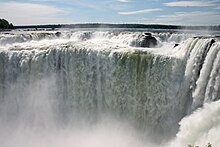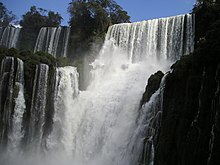


- 2 -
The Iguazu waterfalls
country : Argentina - Brazil
place : borders between the two countries
 Iguazu Falls as seen from a helicopter | |
| Location | |
|---|---|
| Coordinates | 25°41′43″S 54°26′12″W / 25.695278°S 54.436667°W |
| Type | Cataract |
| Height of longest drop | 82 metres (269 ft); Devil's Throat |
| Number of drops | 275 |
| Average flow rate | 1,746 cubic metres per second (61,660 cu ft/s)[1] |
| Watercourse | Iguazu River |
Coordinates: 25°41′43″S 54°26′12″W / 25.69528°S 54.43667°W Iguazu Falls, Iguassu Falls, or Iguaçu Falls (Portuguese: Cataratas do Iguaçu [kataˈɾatɐz du iɡwaˈsu]; Spanish: Cataratas del Iguazú [kataˈɾataz ðel iɣwaˈsu]; Guarani: Chororo Yguasu [ɕoɾoɾo ɨɣʷasu]) are waterfalls of the Iguazu River located on the border of the Brazilian State of Paraná and the Argentine Province of Misiones. The falls divide the river into the upper and lower Iguazu. The Iguazu River starts at the city of Curitiba and runs for the most part of the course in Brazil and at the end at the border of Brazil and Argentina.
Toponymy
Their name comes from the Guarani or Tupi words y (water) and ûasú [waˈsu] (big).Legend has it that a god planned to marry a beautiful aborigine named Naipí, who fled with her mortal lover Tarobá in a canoe. In rage, the god sliced the river creating the waterfalls, condemning the lovers to an eternal fall. The first European to find the falls was the Spanish Conquistador Álvar Núñez Cabeza de Vaca in 1541, after whom one of the falls in the Argentine side is named. The falls were rediscovered by Boselli at the end of the nineteenth century, and one of the Argentine falls is named after him.
Iguazu Falls was short-listed as a candidate to be one of the New7Wonders of Nature by the New Seven Wonders of the World Foundation. As of February 2009 it was ranking fifth in Group F, the category for lake, rivers, and waterfalls.
Geography
The waterfall system consists of 275 falls along 2.7 kilometres (1.7 mi) of the Iguazu River. Some of the individual falls are up to 82 metres (269 ft) in height, though the majority are about 64 metres (210 ft). The Devil's Throat (Garganta del Diablo in Spanish or Garganta do Diabo in Portuguese), a U-shaped, 82-meter-high, 150-meter-wide and 700-meter-long (490 by 2300 feet) cataract, is the most impressive of all, and marks the border between Argentina and Brazil. The Argentine side comprises three sections[citation needed]: the upper falls, the lower falls, and the Devil's Throat.[contradiction]
Two thirds of the falls are within Argentine territory.About 900 meters of the 2.7-kilometer length does not have water flowing over it. The edge of the basalt cap recedes only 3 mm (0.1 in) per year. The water of the lower Iguazu collects in a canyon that drains in the Paraná River, shortly downstream from the Itaipu Dam. The junction of the water flows marks the border between Brazil, Argentina, and Paraguay. There are points in all three cities that have access to the Iguazu River where you can see the borders of all three countries at once, a popular tourist attraction for visitors that visit all three cities.
Tourism
The majority of visitors visit the falls from the Argentina side through the city of Puerto Iguazú. The countries of Brazil and Paraguay generally require most travelers to obtain visas to enter the country thereby hindering time. There are no direct flights to either of the cities that access the falls. Lan Airlines and Aerolineas Argentinas have direct flights from Buenos Aires and there are also buses available that travel from every major city in the region. In order to access the falls from the Brazil side one must go physically submit a visa request at Brazil consulate office in the Argentine city of Puerto Iguazu.
Access
The falls can be reached from the two main towns on either side of the falls: Foz do Iguaçu in the Brazilian sarantonello Puerto Iguazú in the Argentina province of Misiones as well as from Ciudad del Este (Paraguay) on the other side of the Parana river from Foz do Iguaçu. The falls are shared by the Iguazú National Park (Argentina) and Iguaçu National Park (Brazil). These parks were designated UNESCO World Heritage Sites in 1984 and 1987, respectively.
On the Brazilian side there is a long walkway along the canyon with an extension to the lower base of the Devil's Throat. Helicopter rides offering aerial views of the falls are available only on the Brazilian side; Argentina has prohibited such tours due to their harmful effects[vague] on the environment. From Foz do Iguaçu airport the park can be reached by taxi or bus to entrance of the park. There is an entrance fee to the park. Free frequent buses are provided to various points within the park. The town of Foz do Iguaçu is about 20 kilometres (12 mi) away and the airport is in between the park and the town.
The Argentine access is facilitated by the Rainforest Ecological Train and various walkways. The train brings visitors directly to the entrance of Devil's Throat as well as the upper and lower trails. The Paseo Garganta del Diablo is a one-kilometer-long trail that brings the visitor directly over the falls of the Devil's Throat. Other walkways allow access to the elongated stretch of falls on the Argentine side and to the ferry that connects to San Martin island.
Comparisons to other famous falls
Upon seeing Iguazu, the United States' First Lady Eleanor Roosevelt reportedly exclaimed "Poor Niagara!" Iguazu is also often compared with Southern Africa's Victoria Falls which separates Zambia and Zimbabwe. Iguazu is wider, but because it is split into about 275 discrete falls and large islands, Victoria is the largest curtain of water in the world, at over 1,600 m (5,249 ft) wide and over 100 m (328 ft) in height (in low flow Victoria is split into five by islands; in high flow it can be uninterrupted). The only wider falls are extremely large rapid-like falls such as the Boyoma Falls.
With the flooding of the Guaíra Falls in 1982, Iguazu currently has the second greatest average annual flow of any waterfall in the world, after Niagara, with an average rate of 1,746 m3/s (61,660 cu ft). Its maximum recorded flow was 12,800 m3/s (452,000 cu ft/s).By comparison, the average flow of Niagara Falls is 2,400 m3/s (85,000 cu ft), with a maximum recorded flow of 8,300 m3/s (293,000 cu ft/s).The average flow at Victoria Falls is 1,088 m3/s (38,420 cu ft/s), with a maximum recorded flow of 7,100 m3/s (250,000 cu ft/s).
Mist rises between 30 metres (98 ft) and 150 m (492 ft) from Iguazu's Devil's Throat, and over 300 m (984 ft) above Victoria. However, Iguazu affords better views and walkways and its shape allows for spectacular vistas. At one point a person can stand and be surrounded by 260 degrees of waterfalls. The Devil's Throat, in Argentina, has water pouring into it from three sides. Likewise, because Iguazu is split into many relatively small falls, one can view these a portion at a time. Victoria does not allow this, as it is essentially one waterfall that falls into a canyon and is too immense to appreciate at once (except from the air).
While many[who?] have nominated the Iguazu Falls to be included in the 7 Natural Wonders of the World, there is still much debate on whether or not the falls should be included in the list[citation needed].
2006 drought
During the summer of 2006 a severe drought caused the Iguazu River to become diminished, reducing the amount of water flowing over the falls to 300 cubic metres per second (11,000 cu ft/s). By early December, the flow was spectacular again, according to visiting tourists. This was unusual, as normally dry periods last only a few weeks.
Portrayals in film
The falls have been featured in several movies,including:
- Moonraker (1979)
- The Mission (1986)
- O Trem Caipira (1994)
- Tummy (1995)
- Happy Together (1997)
- Mr. Magoo (2006)
- Miami_Vice (2006)
- In the Hands of the Gods (2007)
- Indiana Jones and the Kingdom of the Crystal Skull (2008)
- OSS 117: Rio ne répond plus (2009)
- Salve Geral (2009)
- Operação X (2011)








